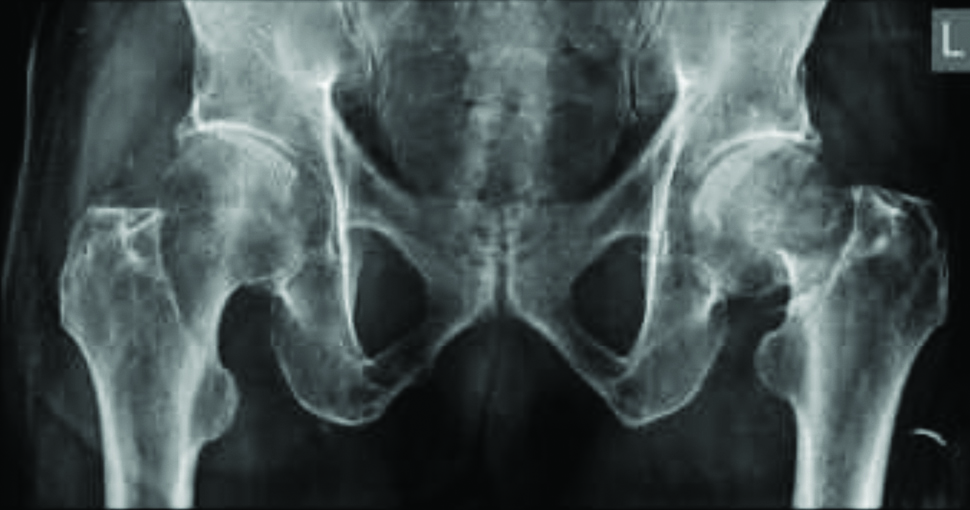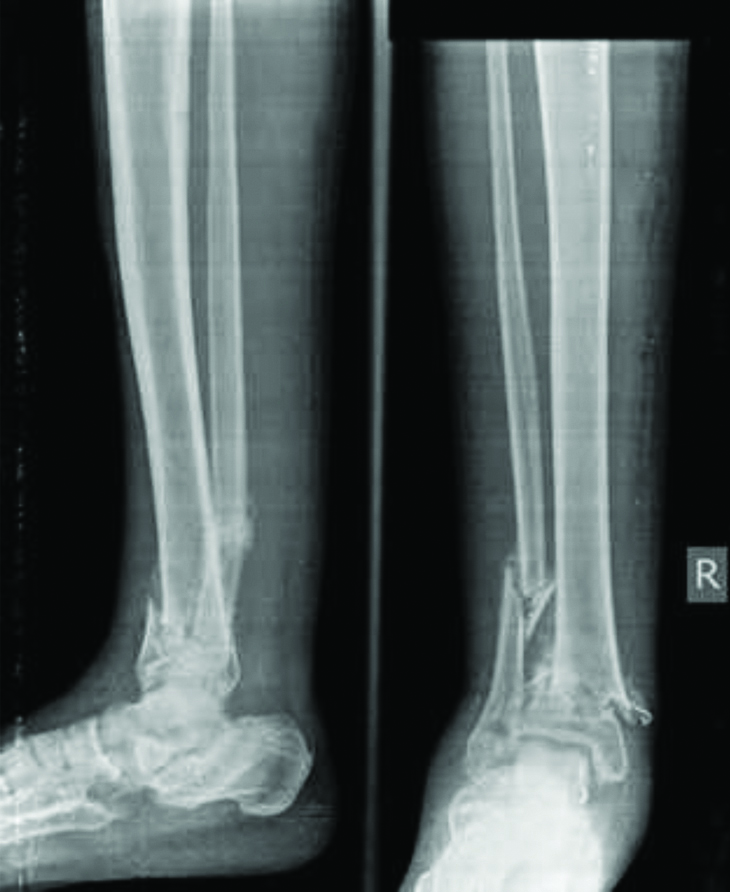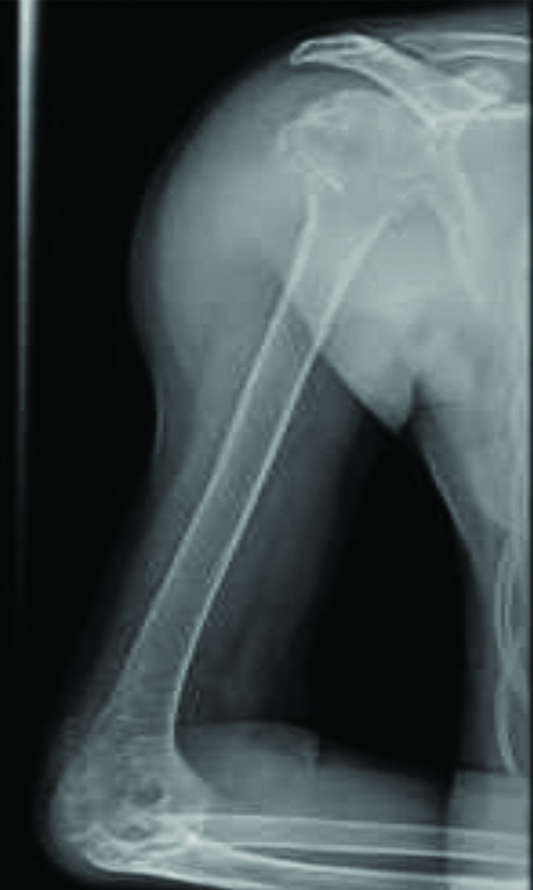Elderly Patients with Trauma: Radiologist’s Perspective of Burden of Disease in a Nigerian Sub-Urban Tertiary Hospital
Ayodeji Anike Olatunji1, Mojisola Adejoke Olusola-Bello2
1 Consultant Radiologist, Department of Radiology, Olabisi Onabanjo University Teaching Hospital, Sagamu, Ogun, Nigeria.
2 Consultant Radiologist, Department of Radiology, Olabisi Onabanjo University Teaching Hospital, Sagamu, Ogun, Nigeria.
NAME, ADDRESS, E-MAIL ID OF THE CORRESPONDING AUTHOR: Dr. Ayodeji Anike Olatunji, Hospital Road, P.M.B. 2001, Sagamu, Ogun, Nigeria.
E-mail: ayodeji.olatunji@yahoo.com
Introduction
Fractures are known to be common among older and elderly persons of age 60 years and above, partly because of bone weakness or increase in frequency of falls and trauma. Data on fractures in elderly are scarce and there is need to document frequencies and predisposing factor in our community.
Aim
To review the radiographs of patients aged 60 years and above and to determine the frequency of fracture, sex distribution, associated event, and bones involved.
Materials and Methods
The present study was retrospective study in which the radiographs of elderly patients were collected from the radiology department between January, 2016 to November, 2018 and were reviewed to determine the prevalence and causes of fractures, as well as factors associated with them.
Results
Of the 561 radiographs reviewed, fractures were found in 73, consisting of 28 in men and 45 in women. Thirty-eight, (53%) of the fractures occurred in the 60-70 years age group. Fracture on left side was more common and females had fracture more on the left side in 27 patients as against 17 on the right side, with one having fracture in the pubic bone. Fractures were associated with trauma, falls and Road Traffic Accidents (RTA) equally. The bones of the lower limbs were involved in 50 cases, while those of the upper limb were involved in 22 cases, with only one in the axial skeleton. The femur was involved in 23 (31.5%) of the cases.
Conclusion
The study established the vulnerability of elderly people aged 60-70 years, particularly women, to fractures. There is a constant need for adequate social protection policy to be implied for such vulnerable group of people.
Radiographs, Road traffic accidents fracture, Social protection policy
Introduction
The population of Nigerians by the 2007 population census was estimated to be about 160 Million, with 4.3% consisting of the elderly people [1]. There is no current United Nations’ standard criterion for classifying people as elderly, but there is an agreed cut off age of 60+ years referred to as the older population [2]. Africa’s population is aging, although at a slower pace than the developing world. By 2050, the proportion of people aged 60 and over in the total population is projected to increase from 5% to 10% with an absolute number of older persons projected to increase from 47.4 million in 2005 to 193 million [3]. In Nigeria, the population of the elderly is gradually increasing as the crude mortality rates are gradually decreasing [4]. Generally, older people are frail, have co-morbidities, experience declining organ function, and are prone to consuming multiple drugs with their side effects [5]. There are also declining physical activity, which additionally in Nigeria is associated with decrease in personal income and care resulting in proneness to injuries and diseases [1].
Trauma is defined as a physical wound or injury such as a fracture or blow [6] and a disease process that can affect all age groups [7] and has been reported to be a major reason for emergency room admissions [8]. There is no credible national, regional or institutional trauma registry thus making documentation of injuries inadequate [7,9]. However, trauma is the fifth leading cause of death in the geriatrics in USA [5]. Because of the aging process, osteoarthritis, osteoporosis and osteopenia predispose the older adults to fractures even from minor trauma and a simple fall can cause spinal compression fractures, wrist, pelvic, hip and skull fractures [10].
Radiology plays an important role in early work-up of the older persons. Computerised Tomography (CT) has become the primary imaging modality which is most commonly used in developed country [11]. But in developing country such as Nigeria, plain Radiography is still the most widely available and affordable mode of investigation. This may lead to an under estimation of the injury severity and thus leads to increase in morbidity and mortality. The pattern of injury in elderly patients is different from those seen in the younger persons as they are susceptible to serious injury even from minor trauma [11].
Although falls, motor vehicle collisions and automobile are common causes [11] in developed countries, there is a dearth of documented information to make such assertions in our own environment. Therefore, the present study was conducted with an aim to find out the demographics of the older persons involved in trauma, the anatomic areas most frequently involved.
Materials and Methods
A retrospective study was done on radiographs of all elderly patients referred from various arms of the hospital to the Radiology department. The study period was from January 2016 to November 2018, and was carried out in accordance with the principle of Helsinki declaration. The review included patients from 60 years and above, for whom skeletal radiographic investigations were requested. The radiographs were reviewed by two radiologists and consensus was reached in respect of each. The relevant history was retrieved from case notes wherever available. Patients younger than 60 years, with no history recorded, or for whom incomplete information including age or sex or area of investigation was absent or incomplete were excluded. Patients whose radio-diagnoses were not clearly stated were also excluded.
Statistical Analysis
Analysis of data was done with an SPSS version 21. The results were presented in-frequencies and percentages and non-parametric variables were analysed using chi-square analysis, with level of significance set at p<0.05.
Results
A total of 561 patient’s radiographs were reviewed. A total of 73 i.e., 13% of all patients, had fractures in one or more bones, of which 28 (38.4%) were males and 45 (61.6%) were females. The age range involved in the study was 60-90 years with a mean of 71.19±7.33 years. The most frequently involved age group was the 60-70 years old involving 38 of the patients [Table/Fig-1].
Frequency of fracture and side of the body involved.
| Age group (years) | Frequency of fractures | Limb side |
|---|
| Number | Percent | Right | Left | Both | Not indicated | Total |
|---|
| 60-65 | 15 | 21.3 | 7 | 7 | 0 | | 14 |
| 66-70 | 23 | 32.0 | 8 | 14 | 0 | 1 | 22 |
| 71-75 | 15 | 20.0 | 5 | 9 | 0 | 1 | 14 |
| 76-80 | 14 | 18.7 | 6 | 7 | 2 | | 14 |
| 81-85 | 3 | 4.0 | 2 | 1 | 0 | | 3 |
| 86-90 | 3 | 4.0 | 2 | 1 | 0 | | 3 |
| Total | 73 | 100.0 | 30 | 39 | 2 | 2 | 73 |
Forty-five (60%) of the 73 fractures occurred in female patients, making females more vulnerable. The right and left sides were equally involved in the male patients, but the left side was more frequently involved in female patients [Table/Fig-2].
Sex and side of body involved with fracture.
| Sex | Number of fractures | Side involved |
|---|
| Number | % | Right | Left | *Others | Unindicated | Total |
|---|
| Male | 28 | 40 | 14 | 13 | 1 | 0 | 28 |
| Female | 45 | 60 | 17 | 27 | 1 | 1 | 46 |
| Total | 73 | 100 | 31 | 40 | 2 | 1 | **74 |
*Hip joint in the male and Pubic bone in the female
**One patient had fractures on both sides, i.e., total number of fractures was one more than number
Out of 11 patients who had fractures due to RTA 8 were males [Table/Fig-3].
Sex and cause of fracture.
| Sex | Causes of fractures | Total |
|---|
| Trauma | Fall | RTA | Presented as other conditions | No cause stated |
|---|
| Male | 2 | 2 | 8 | 8 | 8 | 28 |
| Female | 8 | 8 | 3 | 11 | 15 | 45 |
| Total | 10 | 10 | 11 | 19 | 23 | 73 |
F=8.55
p=0.036
The most involved bone in fractures was the Femur, occurring in 23 (31.5%) patients [Table/Fig-4]. Examples of femoral, tibio-fibular, and humeral fractures are shown in [Table/Fig-5,6 and 7], respectively.
Anatomic site and bones involved in fractures.
| Anatomic site | Name of bone | Male | Female | Total |
|---|
| Lower limb | Femur | 7 | 16 | 23 |
| Tibio-fibula | 4 | 5 | 9 |
| Metatarsal | 2 | 7 | 9 |
| Tibia | 3 | 2 | 5 |
| Fibula | 1 | 1 | 2 |
| Patella | 1 | 0 | 1 |
| Pubic | 0 | 1 | 1 |
| Sub-total | 18 | 32 | 50 |
| Upper limb | Humerus | 6 | 3 | 9 |
| Carpal | 0 | 4 | 4 |
| Ulna | 1 | 2 | 3 |
| Radius | 2 | 0 | 2 |
| Phalanges | 0 | 1 | 1 |
| Elbow | 0 | 1 | 1 |
| Metacarpal | 1 | 0 | 1 |
| Clavicle | 0 | 1 | 1 |
| Sub-total | 10 | 12 | 22 |
| Axial | Thoracic | 0 | 1 | 1 |
| Sub-total | 0 | 1 | 1 |
| All Sites | Grand total | 28 | 45 | 73 |
Radiograph showing fracture of proximal femur.

Radiograph showing fracture of distal tibia and fibula.

Radiograph showing proximal humeral fracture.

Discussion
Our results show that elderly women were more affected than elderly men. This is in agreement with findings in other studies that older women are more frequently involved in fractures [12,13], with the 60-70 years old being most frequently affected. This may not be unconnected with the fact that people in this age are still active and mobile, having just retired or planning to retire and return to another level of lifestyle to cope with post-retirement engagements.
The most frequent reason for requesting radiographic study was suspected fracture. Reason(s) for fractures were not available in all patients, but where available, RTA, falls, and trauma had similar frequencies of occurrence. This is in line with previous report that vehicle collision accounts for up to one-quarter of patients with geriatric trauma [14]. Moore had opined that improvement in technology and medical care will make older people to be more active and productive thus making them more prone to road traffic injuries and trauma [15]. Although, no specific study in this age group is available to the authors in Nigeria, previous studies on trauma in the country claimed high prevalence rates of RTA as mechanism to be reckoned within developing for the management of road traffic injuries in available health centres [8]. Our study however did not find any difference in the prevalence’s of RTA, trauma and falls. It is however possible that RTA may be included among those grouped as trauma. This cannot be ascertained because of the retrospective nature of the study.
The risk of falling is known to increase with age, the consequence of which is dependent on the impact of fall and the strength of the bone of the individual involved [16]. Falls are also known to be a major cause of morbidity and mortality in the elderly [3], while also causing fractures more frequently involving the limbs [17].
Our finding of the dominance of appendicular skeletal fractures is in agreement with the report of Naraynsingh R et al., [17]. The low prevalence of pathological fractures and wedge collapse of the spine and spondylosis may imply that in our environment, osteoporosis may not be a serious health issue among the age group under study. This is probably related to the fact that the community is largely sub-urban with a number of older populations still being actively engaged in farming, requiring some measure of physical exercise.
The bone most frequently involved is the femur, followed by the tibia and fibula. This agrees with previous finding that older patients if and when they fall, injure more their limbs and head [17]. This may explain the relative high morbidity attached to femoral fracture in the age group because of the poor ability to walk or move around freely after the incident. About one-third of these women are said to become permanently dependent on activities of daily living post injury [5]. The other pattern of fractures seen in this study are fractures of the humerus which is third most common, in agreement with the findings in Adewale A et al., which was said to be mostly from direct trauma to the arm or shoulder or via axial loading from “Fall on Outstretched Hands” (FOOSH) injuries [10].
Ankle fractures cannot be ignored in this study, as it was relatively common (6.8%) and according to previous study in (USA), these are more common in female white than male whites and are caused by falls on uneven pavement or down the staircase with twisting of the ankle [10]. However, the pubic bone which had been observed to be more frequently involved in elderly fractures in previous studies [5] was noted to be few (1.36%) in this present study. This may probably be due to mechanism of injury which is different in the present study.
Limitation
The retrospective nature of the study meant that not all information could be collected, as they were not stated in the case notes.
Conclusion
Fractures in the elderly in this community constituted 13% of all radiographs reviewed, and was most prevalent in the 60-70 years age group. Road traffic injuries, falls and trauma were the main causes of fractures. Women were generally more prone to fractures than men. Bones of the extremities were more involved especially the Femur and the Humerus.
*Hip joint in the male and Pubic bone in the female
**One patient had fractures on both sides, i.e., total number of fractures was one more than number
F=8.55
p=0.036
Author Declaration:
Financial or Other Competing Interests: No
Was Ethics Committee Approval obtained for this study? Yes
Was informed consent obtained from the subjects involved in the study? Yes
For any images presented appropriate consent has been obtained from the subjects. NA
PLAGIARISM CHECKING METHODS: [Jain H et al.]
Plagiarism X-checker: May 18, 2019
Manual Googling: Aug 17, 2019
iThenticate Software: Sep 20, 2019 (8%)
[1]. Adebowale SA, Atte O, Ayeni O, Elderly well-being in a rural community in north central Nigeria, Sub-Saharan AfricaPublic Health Research 2012 2(4):92-101.10.5923/j.phr.20120204.05 [Google Scholar] [CrossRef]
[2]. WHO: The World Population Prospects: 1015 Revision. 2015. https://www.un.org/development/desa/publication/world-population-prospects-2015revised.html [Google Scholar]
[3]. Kalula SZ, A WHO Global Report on falls among Older Persons. Prevention of falls in Older persons: Africa Case studyUnited Nations Population Division (2006)World Population Prospects 2004 Revision). https://www.who.int/ageing/projects/AFRO.pdf.downloaded 12/07/2018 [Google Scholar]
[4]. National Population Commission and Micro International USA. (2008). Nigeria Demographic and Health Survey. 2009: http://www.measuredhs.com. Assessed on line 12/07/2018 [Google Scholar]
[5]. Sadro CT, Sandstrom CK, Verma N, Gunn ML, Geriatric trauma: A radiologist’s guide to imaging trauma patients aged 65 years and olderRadiographics 2015 35:1263-85.Published on line 10.1148/rg201514013010.1148/rg.201514013026065932 [Google Scholar] [CrossRef] [PubMed]
[6]. Nwobi IC, Kurama MB, Flavious NB, Abubakar A, Shettima AB, Hassan JM, Pattern of radiographic findings in trauma of the upper extremities at federal teaching hospital gombe, NigeriaNigerian Journal of imaging and Radiation Therapy 2015 4(1):28-31. [Google Scholar]
[7]. Madubueze CC, Chukwu COO, Omoke NI, Oyakhilome OP, Ozo C, Road Traffic injuries seen in a Nigerian teaching hospitalInternational Orthopaediatics (SICOT) 2011 35:743-46.10.1007/s00264-010-1080-y20623283 [Google Scholar] [CrossRef] [PubMed]
[8]. Thanni LOA, Kehinde OA, Trauma at a Nigerian teaching hospital: Pattern and documentation of presentationAfr Health Sci 2006 6(2):104-07.PMID: 16916301(8) [Google Scholar]
[9]. Callaway DW, Wolfe R, Geriatric traumaEmerg Med Clin North Am 2007 25(3):837-60.10.1016/j.emc.2007.06.00517826220 [Google Scholar] [CrossRef] [PubMed]
[10]. Adewale A, Leonard M, Trauma in older adults: an overview of injury patterns and managementEmergency Medicine Reports 2012 https://www.reliasmedia.com/articles/76680 (assessed on 28/11/2018 [Google Scholar]
[11]. Wojda TR, Cornejo K, Valenza PL, Carolan G, Sharpe RP, Mira AA, Medical demographics in sub-Saharan Africa: Does the proportion of Elderly patients in accident and emergency units mirror life expectancy trends?J Emerg Trauma Shock 2016 9(3):m122-25.10.4103/0974-2700.18527827512334 [Google Scholar] [CrossRef] [PubMed]
[12]. Holloway KL, Yousif D, Bucki-Smith G, Hosking S, Betson AG, Williams LJ, Lower limb fracture presentations at a regional hospitalArch Osteoporos 2017 12(1):7510.1007/s11657-017-0369-528849404 [Google Scholar] [CrossRef] [PubMed]
[13]. Musschitz C, Kocijan R, Baierl A, Dormann R, Feichtinger X, Haschka J, Preceding and subsequent high- and low-trauma fracture patterns-a 13-year epidemiological study in females and males in AustriaOsteoporos Int 2017 28(5):1609-18.Doi: 10. 1007/s00198-017-3925-3. Epub 2017 Jan 3010.1007/s00198-017-3925-328138718 [Google Scholar] [CrossRef] [PubMed]
[14]. Bonne S, Schuere DJ, Trauma in the older adult: Epidemiology and evolving geriatric trauma principlesClin Geriatr Med 2013 29:137-50.10.1016/j.cger.2012.10.00823177604 [Google Scholar] [CrossRef] [PubMed]
[15]. Moore BT, Trauma in the elderlyMo Med 2003 100(5):515-17. [Google Scholar]
[16]. Woolf AD, Akesson K, Preventing fractures in elderly peopleBMJ 2003 327(7406):89-95.10.1136/bmj.327.7406.8912855529 [Google Scholar] [CrossRef] [PubMed]
[17]. Naraynsingh R, Sammy I, Paul JF, Nunes P, Trauma in the elderly in Trinidad and Tobago: A cross-sectional studyEur J Emerg Med 2015 22(3):219-21.10.1097/MEJ.000000000000019625099529 [Google Scholar] [CrossRef] [PubMed]